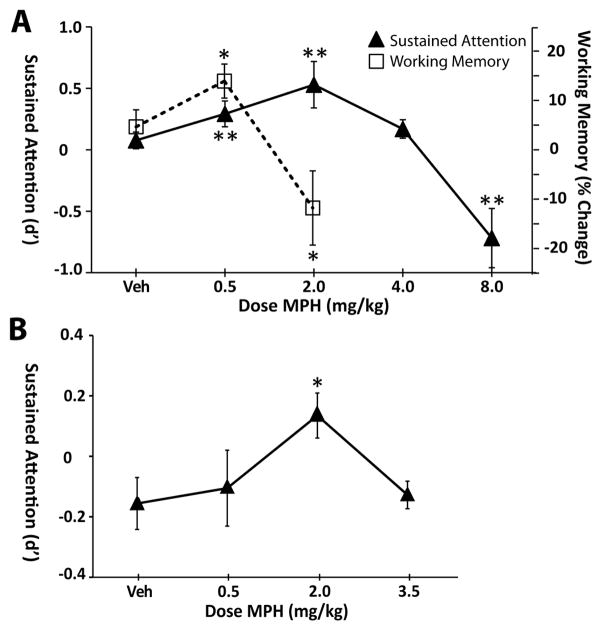Figure 1.
MPH exerts a broad inverted-U dose-dependent improvement in performance in a sustained attention test. Panel A: Shown are the effects of varying doses of MPH on performance in a signal detection test of sustained attention as measured by change in d′ from baseline performance (Madison, WI testing; Triangles, left axis). Relative to vehicle treatment (Veh) 0.5 mg/kg MPH significantly improved performance, consistent with our previous observations (4). 2.0 mg/kg MPH produced an even larger improvement in performance in this task while 4.0 mg/kg MPH did not improve and 8.0 mg/kg MPH significantly impaired performance. The breadth of this dose response curve differs from that seen in a delayed response task of spatial working memory (Squares, right axis; data from 10). For working memory testing, animals were required to alternate arm entries following a delay (10–120 seconds) that yielded 70–80% accurate performance. MPH produces a substantially narrower inverted-U shaped facilitation of working memory performance than seen in the sustained attention task, with maximal improvement occurring at 0.5 mg/kg and impairment at 2.0 mg/kg. Panel B: Effects of varying doses of MPH on sustained attention as tested in Philadelphia, PA. Despite significant differences in testing procedures and baseline levels of performance (see Methods and Results) nearly identical dose-response effects of MPH on sustained attention were obtained to those shown in Panel A, with maximal improvement in performance occurring at 2.0 mg/kg. In particular, the magnitude of the increase in d′ seen with this dose of MPH was nearly identical across the two laboratories. *P < 0.05; **P < 0.01 relative to vehicle treatment.

